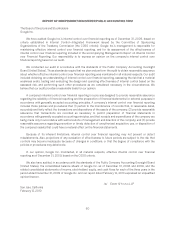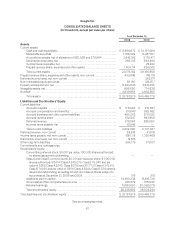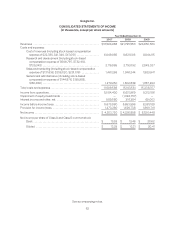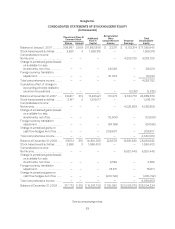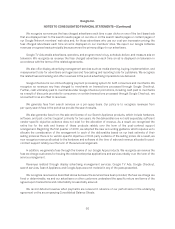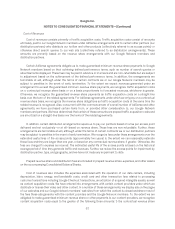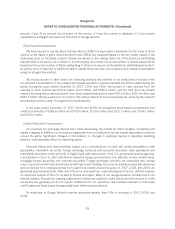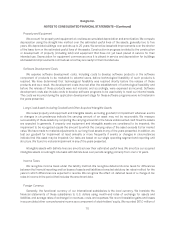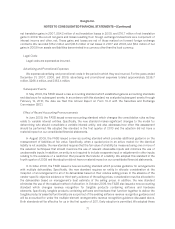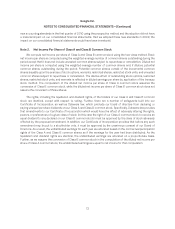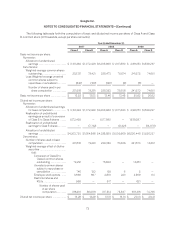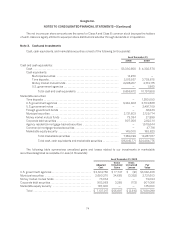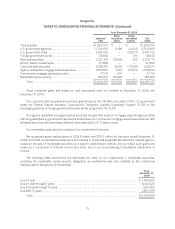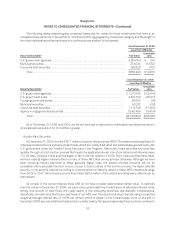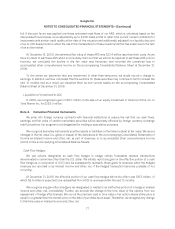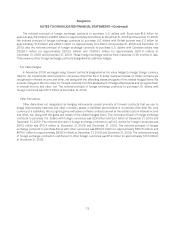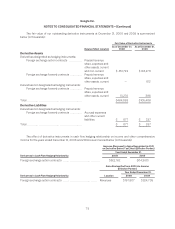Google 2009 Annual Report Download - page 87
Download and view the complete annual report
Please find page 87 of the 2009 Google annual report below. You can navigate through the pages in the report by either clicking on the pages listed below, or by using the keyword search tool below to find specific information within the annual report.Google Inc.
NOTES TO CONSOLIDATED FINANCIAL STATEMENTS—(Continued)
Fair Value of Financial Instruments
The carrying amounts of our financial instruments, including cash and cash equivalents, accounts receivable,
accounts payable, and accrued liabilities, approximate fair value because of their generally short maturities. We
carry marketable securities and foreign currency contracts at fair value. See Notes 3 and 4 below for more
information.
Cash and Cash Equivalents and Marketable Securities
We invest our excess cash primarily in highly liquid debt instruments of the U.S. government and its agencies,
municipalities in the U.S., debt instruments issued by foreign government, time deposits, money market mutual
funds, mortgage-backed securities, and corporate securities. We classify all highly liquid investments with stated
maturities of three months or less from date of purchase as cash equivalents and all highly liquid investments with
stated maturities of greater than three months as marketable securities.
We determine the appropriate classification of our investments in marketable securities at the time of
purchase and reevaluate such designation at each balance sheet date. We have classified and accounted for our
marketable securities as available-for-sale. We may or may not hold securities with stated maturities greater than
12 months until maturity. After consideration of our risk versus reward objectives, as well as our liquidity
requirements, we may sell these securities prior to their stated maturities. As we view these securities as available
to support current operations, we classify securities with maturities beyond 12 months as current assets under the
caption marketable securities in the accompanying Consolidated Balance Sheets. We carry these securities at fair
value, and report the unrealized gains and losses, net of taxes, as a component of stockholders’ equity, except for
unrealized losses determined to be other than temporary which we record as interest income and other, net. We
determine any realized gains or losses on the sale of marketable securities on a specific identification method, and
we record such gains and losses as a component of interest income and other, net.
Non-Marketable Equity Securities
We have accounted for non-marketable equity security investments primarily at cost because we do not have
significant influence over the underlying investees.
Impairment of Marketable and Non-Marketable Securities
We periodically review our marketable securities, as well as our non-marketable equity securities, for
impairment. If we conclude that any of these investments are impaired, we determine whether such impairment is
“other-than-temporary.” Factors we consider to make such determination include the duration and severity of the
impairment, the reason for the decline in value and the potential recovery period, and our intent to sell, or whether it
is more likely than not that we will be required to sell, the investment before recovery. If any impairment is
considered “other-than-temporary,” we will write down the asset to its fair value and take a corresponding charge
to our Consolidated Statements of Income.
Accounts Receivable
We record accounts receivable at the invoiced amount and we do not charge interest. We maintain an
allowance for doubtful accounts to reserve for potentially uncollectible receivables. We review the accounts
receivable by amounts due by customers which are past due to identify specific customers with known disputes or
collectability issues. In determining the amount of the reserve, we make judgments about the creditworthiness of
significant customers based on ongoing credit evaluations. We also maintain a sales allowance to reserve for
potential credits issued to customers. We determine the amount of the reserve based on historical credits issued.
69



